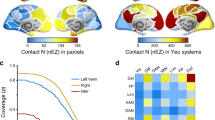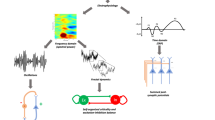Abstract
Animal studies have shown robust electrophysiological activity in the sensory cortex in the absence of stimuli or tasks. Similarly, recent human functional magnetic resonance imaging (fMRI) revealed widespread, spontaneously emerging cortical fluctuations. However, it is unknown what neuronal dynamics underlie this spontaneous activity in the human brain. Here we studied this issue by combining bilateral single-unit, local field potentials (LFPs) and intracranial electrocorticography (ECoG) recordings in individuals undergoing clinical monitoring. We found slow (<0.1 Hz, following 1/f-like profiles) spontaneous fluctuations of neuronal activity with significant interhemispheric correlations. These fluctuations were evident mainly in neuronal firing rates and in gamma (40–100 Hz) LFP power modulations. Notably, the interhemispheric correlations were enhanced during rapid eye movement and stage 2 sleep. Multiple intracranial ECoG recordings revealed clear selectivity for functional networks in the spontaneous gamma LFP power modulations. Our results point to slow spontaneous modulations in firing rate and gamma LFP as the likely correlates of spontaneous fMRI fluctuations in the human sensory cortex.
This is a preview of subscription content, access via your institution
Access options
Subscribe to this journal
Receive 12 print issues and online access
$209.00 per year
only $17.42 per issue
Buy this article
- Purchase on Springer Link
- Instant access to full article PDF
Prices may be subject to local taxes which are calculated during checkout






Similar content being viewed by others
References
Llinas, R.R. The intrinsic electrophysiological properties of mammalian neurons: insights into central nervous system function. Science 242, 1654–1664 (1988).
Arieli, A., Sterkin, A., Grinvald, A. & Aertsen, A. Dynamics of ongoing activity: explanation of the large variability in evoked cortical responses. Science 273, 1868–1871 (1996).
Kenet, T., Bibitchkov, D., Tsodyks, M., Grinvald, A. & Arieli, A. Spontaneously emerging cortical representations of visual attributes. Nature 425, 954–956 (2003).
Leopold, D.A., Murayama, Y. & Logothetis, N.K. Very slow activity fluctuations in monkey visual cortex: implications for functional brain imaging. Cereb. Cortex 13, 422–433 (2003).
Laufs, H. et al. Electroencephalographic signatures of attentional and cognitive default modes in spontaneous brain activity fluctuations at rest. Proc. Natl. Acad. Sci. USA 100, 11053–11058 (2003).
Fiser, J., Chiu, C. & Weliky, M. Small modulation of ongoing cortical dynamics by sensory input during natural vision. Nature 431, 573–578 (2004).
Mantini, D., Perrucci, M.G., Del Gratta, C., Romani, G.L. & Corbetta, M. Electrophysiological signatures of resting state networks in the human brain. Proc. Natl. Acad. Sci. USA 104, 13170–13175 (2007).
Steriade, M., Nunez, A. & Amzica, F. A novel slow (<1 Hz) oscillation of neocortical neurons in vivo: depolarizing and hyperpolarizing components. J. Neurosci. 13, 3252–3265 (1993).
Steriade, M., Amzica, F. & Nunez, A. Cholinergic and noradrenergic modulation of the slow (approximately 0.3 Hz) oscillation in neocortical cells. J. Neurophysiol. 70, 1385–1400 (1993).
Grill-Spector, K., Kushnir, T., Hendler, T. & Malach, R. The dynamics of object-selective activation correlate with recognition performance in humans. Nat. Neurosci. 3, 837–843 (2000).
Kanwisher, N. Neural events and perceptual awareness. Cognition 79, 89–113 (2001).
Biswal, B., Yetkin, F.Z., Haughton, V.M. & Hyde, J.S. Functional connectivity in the motor cortex of resting human brain using echo-planar MRI. Magn. Reson. Med. 34, 537–541 (1995).
Lowe, M.J., Mock, B.J. & Sorenson, J.A. Functional connectivity in single and multislice echoplanar imaging using resting-state fluctuations. Neuroimage 7, 119–132 (1998).
Cordes, D. et al. Mapping functionally related regions of brain with functional connectivity MR imaging. AJNR Am. J. Neuroradiol. 21, 1636–1644 (2000).
Greicius, M.D., Krasnow, B., Reiss, A.L. & Menon, V. Functional connectivity in the resting brain: a network analysis of the default mode hypothesis. Proc. Natl. Acad. Sci. USA 100, 253–258 (2003).
Fox, M.D. et al. The human brain is intrinsically organized into dynamic, anticorrelated functional networks. Proc. Natl. Acad. Sci. USA 102, 9673–9678 (2005).
Damoiseaux, J.S. et al. Consistent resting-state networks across healthy subjects. Proc. Natl. Acad. Sci. USA 103, 13848–13853 (2006).
Nir, Y., Hasson, U., Levy, I., Yeshurun, Y. & Malach, R. Widespread functional connectivity and fMRI fluctuations in human visual cortex in the absence of visual stimulation. Neuroimage 30, 1313–1324 (2006).
Vincent, J.L. et al. Intrinsic functional architecture in the anaesthetized monkey brain. Nature 447, 83–86 (2007).
Golland, Y. et al. Extrinsic and intrinsic systems in the posterior cortex of the human brain revealed during natural sensory stimulation. Cereb. Cortex 17, 766–777 (2007).
Fox, M.D. & Raichle, M.E. Spontaneous fluctuations in brain activity observed with functional magnetic resonance imaging. Nat. Rev. Neurosci. 8, 700–711 (2007).
Bitterman, Y., Mukamel, R., Malach, R., Fried, I. & Nelken, I. Ultra-fine frequency tuning revealed in single neurons of human auditory cortex. Nature 451, 197–201 (2008).
Steriade, M., McCormick, D.A. & Sejnowski, T.J. Thalamocortical oscillations in the sleeping and aroused brain. Science 262, 679–685 (1993).
Privman, E. et al. Enhanced category tuning revealed by intracranial electroencephalograms in high-order human visual areas. J. Neurosci. 27, 6234–6242 (2007).
Nir, Y. et al. Coupling between neuronal firing rate, gamma LFP and BOLD fMRI is related to interneuronal correlations. Curr. Biol. 17, 1275–1285 (2007).
Logothetis, N.K., Pauls, J., Augath, M., Trinath, T. & Oeltermann, A. Neurophysiological investigation of the basis of the fMRI signal. Nature 412, 150–157 (2001).
Womelsdorf, T., Fries, P., Mitra, P.P. & Desimone, R. Gamma-band synchronization in visual cortex predicts speed of change detection. Nature 439, 733–736 (2006).
Lu, H. et al. Synchronized delta oscillations correlate with the resting-state functional MRI signal. Proc. Natl. Acad. Sci. USA 104, 18265–18269 (2007).
Mukamel, R. et al. Coupling between neuronal firing, field potentials and FMRI in human auditory cortex. Science 309, 951–954 (2005).
Nelken, I. Processing of complex stimuli and natural scenes in the auditory cortex. Curr. Opin. Neurobiol. 14, 474–480 (2004).
Mitra, P.P., Ogawa, S., Hu, X. & Ugurbil, K. The nature of spatiotemporal changes in cerebral hemodynamics as manifested in functional magnetic resonance imaging. Magn. Reson. Med. 37, 511–518 (1997).
Greicius, M.D., Srivastava, G., Reiss, A.L. & Menon, V. Default-mode network activity distinguishes Alzheimer's disease from healthy aging: evidence from functional MRI. Proc. Natl. Acad. Sci. USA 101, 4637–4642 (2004).
Liu, H. et al. Decreased regional homogeneity in schizophrenia: a resting state functional magnetic resonance imaging study. Neuroreport 17, 19–22 (2006).
Cordes, D., Haughton, V., Carew, J.D., Arfanakis, K. & Maravilla, K. Hierarchical clustering to measure connectivity in fMRI resting-state data. Magn. Reson. Imaging 20, 305–317 (2002).
Golland, Y., Golland, P., Bentin, S. & Malach, R. Data-driven clustering reveals a fundamental subdivision of the human cortex into two global systems. Neuropsychologia 46, 540–553 (2008).
Van de Ven, V.G., Formisano, E., Prvulovic, D., Roeder, C.H. & Linden, D.E. Functional connectivity as revealed by spatial independent component analysis of fMRI measurements during rest. Hum. Brain Mapp. 22, 165–178 (2004).
Johnston, J.M. et al. Loss of resting interhemispheric functional connectivity after complete section of the corpus callosum. J. Neurosci. 28, 6453–6458 (2008).
Niessing, J. et al. Hemodynamic signals correlate tightly with synchronized gamma oscillations. Science 309, 948–951 (2005).
Nir, Y., Dinstein, I., Malach, R. & Heeger, D.J. BOLD and spiking activity. Nat. Neurosci. 11, 523–524 (2008).
Shmuel, A. & Leopold, D.A. Neuronal correlates of spontaneous fluctuations in fMRI signals in monkey visual cortex: Implications for functional connectivity at rest. Hum. Brain Mapp. 29, 751–761 (2008).
Barbour, D.L. & Wang, X. Auditory cortical responses elicited in awake primates by random spectrum stimuli. J. Neurosci. 23, 7194–7206 (2003).
Phan, M.L. & Recanzone, G.H. Single-neuron responses to rapidly presented temporal sequences in the primary auditory cortex of the awake macaque monkey. J. Neurophysiol. 97, 1726–1737 (2007).
Tootell, R.B. et al. The retinotopy of visual spatial attention. Neuron 21, 1409–1422 (1998).
Fishbein, I. & Segal, M. Miniature synaptic currents become neurotoxic to chronically silenced neurons. Cereb. Cortex 17, 1292–1306 (2007).
Tononi, G. & Cirelli, C. Sleep function and synaptic homeostasis. Sleep Med. Rev. 10, 49–62 (2006).
Morel, A., Garraghty, P.E. & Kaas, J.H. Tonotopic organization, architectonic fields and connections of auditory cortex in macaque monkeys. J. Comp. Neurol. 335, 437–459 (1993).
Tsodyks, M.V. & Sejnowski, T. Rapid state switching in balanced cortical network models. Network Comput. Neural Syst. 6, 111–124 (1995).
Vogels, T.P., Rajan, K. & Abbott, L.F. Neural network dynamics. Annu. Rev. Neurosci. 28, 357–376 (2005).
Laureys, S. & Boly, M. What is it like to be vegetative or minimally conscious? Curr. Opin. Neurol. 20, 609–613 (2007).
Rechtschaffen, A. & Kales, A.A. A Manual of Standardized Terminology, Techniques, and Scoring System for Sleep Stages of Human Subjects (US Department of Health, Education and Welfare, Bethesda, Maryland, 1968).
Acknowledgements
We thank the participants for volunteering to take part in the study; A.D. Ekstrom, E. Isham, E. Ho, T.A. Fields, and E. Behnke for technical assistance at UCLA; C. Wilson and J. Ogren for help with sleep recordings and staging; D. Yossef, S. Nagar, R. Cohen, C. Yosef, G. Yehezkel and the EEG technicians for assistance at the Tel Aviv Medical Center; and R. Paz and E. Schneidman for helpful discussions and feedback. This study was funded by the Israel Science Foundation, Minerva and Benoziyo Center grants to R. Malach, a US-Israel Binational Science Foundation grant to I.F. and R. Malach and a Human Frontier Science Program Organization fellowship to R. Mukamel.
Author information
Authors and Affiliations
Corresponding author
Supplementary information
Supplementary Text and Figures
Supplementary Figures 1–10, Supplementary Tables 1 and 2, and Supplementary Methods (PDF 1369 kb)
Rights and permissions
About this article
Cite this article
Nir, Y., Mukamel, R., Dinstein, I. et al. Interhemispheric correlations of slow spontaneous neuronal fluctuations revealed in human sensory cortex. Nat Neurosci 11, 1100–1108 (2008). https://doi.org/10.1038/nn.2177
Received:
Accepted:
Published:
Issue Date:
DOI: https://doi.org/10.1038/nn.2177
This article is cited by
-
Direct intracranial recordings in the human angular gyrus during arithmetic processing
Brain Structure and Function (2023)
-
Increased fMRI connectivity upon chemogenetic inhibition of the mouse prefrontal cortex
Nature Communications (2022)
-
1024-channel electrophysiological recordings in macaque V1 and V4 during resting state
Scientific Data (2022)
-
Anesthetic modulations dissociate neuroelectric characteristics between sensory-evoked and spontaneous activities across bilateral rat somatosensory cortical laminae
Scientific Reports (2022)
-
Muskelin regulates actin-dependent synaptic changes and intrinsic brain activity relevant to behavioral and cognitive processes
Communications Biology (2022)



